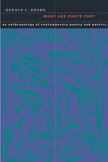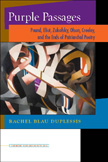What Are Poets For?
“Gerald Bruns, one of our most distinguished philosophical critics, here turns his attention to the cutting-edge poetry and poetics of the past few decades, seen through the prism of such theorists as Adorno, Blanchot, and Levinas. Bruns’s readings are everywhere animated by his profound learning and his knowledge of the larger poetic tradition. For anyone interested in the avant-garde today, What Are Poets For? is an indispensable book.”—Marjorie Perloff, author, Unoriginal Genius
“Gerald Bruns’s learning is prodigious, and he seems not only to have read but to recall on command just about all of even minor aesthetic documents (and the basic scholarship on them) since Kant. Yet he holds his learning lightly, bringing it to bear only when it is called for to illuminate a point. Moreover, he writes elegantly, fluidly, and lucidly on quite difficult material, and he has excellent taste. Most important, Bruns makes the strongest and richest statements I know of an aesthetic that drives the work of his authors.”—Charles Altieri, author, The Art of Modern American Poetry
Conceptions and practices of poetry change not only from time to time and from place to place but also from poet to poet. This has never been more the case than in recent years. Gerald Bruns’s magisterial What Are Poets For? explores typographical experiments that distribute letters randomly across a printed page, sound tracks made of vocal and buccal noises, and holographic poems that recompose themselves as one travels through their digital space. Bruns surveys one-word poems, found texts, and book-length assemblies of disconnected phrases; he even includes descriptions of poems that no one could possibly write, but which are no less interesting (or no less poetic) for all of that. The purpose of the book is to illuminate this strange poetic landscape, spotlighting and describing such oddities as they appear, anomalies that most contemporary poetry criticism ignores.
Naturally this breadth raises numerous philosophical questions that Bruns also addresses—for example, whether poetry should be responsible (semantically, ethically, politically) to anything outside itself, whether it can be reduced to categories, distinctions, and the rule of identity, and whether a particular poem can seem odd or strange when everything is an anomaly. Perhaps our task is simply to learn, like anthropologists, how to inhabit such an anarchic world. The poets taken up for study are among the most important and innovative in the late twentieth and early twenty-first centuries: John Ashbery, Charles Bernstein, Paul Celan, Kenneth Goldsmith, Lyn Hejinian, Susan Howe, Karen Mac Cormack, Steve McCaffery, John Matthias, J. H. Prynne, and Tom Raworth. What Are Poets For? is nothing less than a lucid, detailed study of some of the most intractable writings in contemporary poetry.





